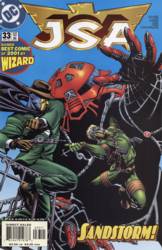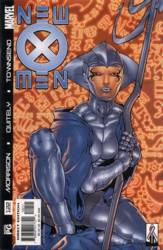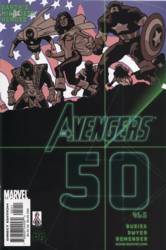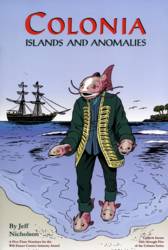






| ||||
Links du jour:
| ||||
Bookshelf:Recently Read: Currently reading:
| ||||
On the Racks LatelyIt's been a while, so let's look at some comic books that have been on the stands lately. These reviews are a bit on the grumpy side, but there's some unabashed praise as we move along.
Jimenez has had an interesting career, including illustrating Devon Grayson's impenetrable JLA/Titans mini-series (the lead-in to one of the more pointless regular series of recent years), and a stellar run on Grant Morrison's The Invisibles, where is clean line and layout work helped keep Morrison's story coherent and even exciting. One is always leery of artists being given writing chores, and perhaps not surprisingly the results here feel... a lot like George Perez's work on the series ten years ago. The art is sumptuous, the plotting rather haphazard and not as "larger-than-life" as one might expect, and the characterizations painstakingly drawn, but perhaps a little too saccharine. The book includes three stories: "Gods of Gotham", in which the three children of the war god Ares possess three of Batman's greatest enemies hoping to bring their father to Earth; and a two-part story in which Wonder Woman's amazons of Themyscira island fight a civil war with their Egyptian brethren who have settled at the other end of the island. Wonder Woman has built up a large cast and imposing backstory in its current incarnation, and Jimenez does his best to present it all for a new reader. The volume winds up with a short piece where Lois Lane interviews Wonder Woman which neatly contrasts DC's top two women with the ever-present shadow of the Man of Steel in the background. I think it's the huge cast that ultimately weighs down the story, since we rarely get the focus on Diana - the star of the book - that it seems we deserve. Troia and Fury and Hippolyta and Artemis and all the rest are worthy characters, but they're all alpha females, and their conflicts either seem external to their essential characters, or are aborted through happenstance (or because they were fomented by outside manipulation) before they can get serious. And that's what this series needs most: A solid shot of seriousness.
Like Wonder Woman, JSA suffers from having way too many characters, and adds to this having way to little raison d'etre. The JSA in the 1970s represented the old guard of heroes, and the contrast of the "workingman" heroes carrying on the standard to the next generation contrasted neatly with the "legends" (Superman, Batman) who had retired but whose influence was still felt. Most of the heroes in JSA are established, adult figures who know who they are and live in a world full of hundreds (thousands!) of heroes. They're not "the new generation", they're a handful among a crowd. JSA is nearly devoid of character: Why the heroes are here, what motivates them to do their thing, and how these motivations cause them to come into conflict with each other are all mysteries to me. The most interesting elements from earlier in the series - what the new Doctor Fate thinks of his role, the questionable acts perpetrated by Atom Smasher when his mother was killed - have been peripheral to the simple adventure yarns. The current conflict (apparently to be played out mainly in the pages of the new Hawkman comic) involves the returned Hawkman trying to win back the love of his many lives, Hawkgirl, who wants little to do with him. The current issue is the part of the "Stealing Thunder" storyline, in which the villainous Ultra-Humanite somehow gains control of Johnny Thunder's Thunderbolt and uses it to take over the world. While it's an interesting idea, I'm doubtful that writers David Goyer and Geoff Johns will make it anything more than yet another how-to-defeat-an-invincible-foe story.
Quitely's resume includes Morrison's JLA: Earth 2 graphic novel, and a run on The Authority handling Mark Millar's basically unreadable bloodfests. (In The Authority, one always suspected that Warren Ellis was just having a bit of light fun and pulling a fast one on the establishment. Millar's scripts demonstrate an outright hatred for the establishment and all it represent, and it's all in deadly earnest. But I digress.) Quitely's an elegant draftsman, but his faces - particularly the women - all look basically like silly-putty, and the characters' expressions run the gamut from grimace to indigestion. All that, plus the book still needs fill-in artists. Morrison would have been better off recruiting Phil Jimenez again.
Although he's going out with a lot of noise, Busiek's Avengers has definitely fallen on harder times than it was in three years ago. Artist supreme George Perez finally departed after a respectable three-year run, and his successor, Alan Davis, only lasted a few issues. Current penciller Kieron Dwyer is better than I'd expected, but truthfully there just aren't many artists around who match up to Perez and Davis. And unfortunately the answer to the mystery of what the Triunes, Templar, and Pagan were up to is that they were all in it together trying to prepare to fight off an alien attack! Uhhh... right. I knew that. The big downside here isn't that the payoff to those storylines was so pedestrian, but that it also resulted in the writing-out of Triathlon, the niftiest black character to come along in comics in quite a while, and someone who really kept the Avengers on their toes, both physically and morally. Busiek's had a good run on the title, but what we really want from him is more Astro City.
The Hellboy characters have developed little by little, forming an effective subplot to the ongoing fantastic situations they keep finding themselves in, and the story here (by Mignola, Christopher Golden and Tom Sniegoski) continues that trend, with Johann finding his way into the group, while Abe and Roger contemplate leaving it due to feelings of betrayal. Ryan Sook does about as good an impression of Mignola's art as we could hope for, and I expect this to be the latest in a series of riveting horror yarns.
But that's just the icing: Colonia is different in other ways. There are mermaids, and sentient fish who like to go for walks in human clothing (as the cover depicts). There are talking animals, and ghosts of Spanish soldiers, and (one suspects) all the legends about the New World back in the Olden Days are probably true in this land. It's barely evident, but Jack and his uncles are fighting for their lives, and they barely know the ground-rules. Fans of Bone, Thieves & Kings and Finder will probably enjoy this series, although Nicholson's art is far less polished - and in a much simpler style - than Jeff Smith's or Speed McNeil's. The trade paperback pictured collects the first five issues of the series, which have lots of activity, but still feel like they're setting up the overall story. I guess my biggest worry about the series is either that Nicholson will be forced to abandon it at some point (due to financial concerns), or that it will ramble on for some years without ever reaching a climactic moment (a problem that Finder has had; Bones and Thieves have both had periodic moments of climax, marking the end of one segment and the transition to a new one). We'll just have to wait and see, of course, but if he pulls it off, Colonia looks like it could be something great.
|
||

 JSA (DC Comics) was apparently named the best comic of 2001 by Wizard magazine. Despite the fact that the series is at #33 - nearly 3 years old - I'm hard-pressed to figure out why. Working with a mixture of lifespan-extended heroes from the original 1940s Justice Society, and their replacements from the 1990s (who bear little resemblance to the originals save for their names), the series has been one after another of standard superhero adventure yarns: Fight this villain, save that planet, witness the triumphant return (sigh) of Hawkman to DC continuity: Can you guess what his backstory is this year?
JSA (DC Comics) was apparently named the best comic of 2001 by Wizard magazine. Despite the fact that the series is at #33 - nearly 3 years old - I'm hard-pressed to figure out why. Working with a mixture of lifespan-extended heroes from the original 1940s Justice Society, and their replacements from the 1990s (who bear little resemblance to the originals save for their names), the series has been one after another of standard superhero adventure yarns: Fight this villain, save that planet, witness the triumphant return (sigh) of Hawkman to DC continuity: Can you guess what his backstory is this year? Writer Grant Morrison and artist Frank Quitely have been trying to breathe new life into the X-Men franchise, and the results are mixed. Morrison's strength is to write big stories, pitting invincible heroes against even more invincible threats, with a heavy dose of weird on top of it. As a result, the current New X-Men series (Marvel Comics) sees Charles Xavier's sort-of twin sister take of his body and bring the wrath of the alien Shi'ar empire down on Earth. Morrison's characterization could best be described as "heavy-handed", so the most we can really expect here is a fun, fast, and loud ride. You're always curious as to what he'll do next, but the novelty always seems to wear off after the first couple of stories (c.f. Animal Man, Doom Patrol, JLA, all three of which had a marked drop-off in quality following their first 6 or so issues).
Writer Grant Morrison and artist Frank Quitely have been trying to breathe new life into the X-Men franchise, and the results are mixed. Morrison's strength is to write big stories, pitting invincible heroes against even more invincible threats, with a heavy dose of weird on top of it. As a result, the current New X-Men series (Marvel Comics) sees Charles Xavier's sort-of twin sister take of his body and bring the wrath of the alien Shi'ar empire down on Earth. Morrison's characterization could best be described as "heavy-handed", so the most we can really expect here is a fun, fast, and loud ride. You're always curious as to what he'll do next, but the novelty always seems to wear off after the first couple of stories (c.f. Animal Man, Doom Patrol, JLA, all three of which had a marked drop-off in quality following their first 6 or so issues). Kurt Busiek is close to wrapping up a distinguished four-plus year run on the current Avengers series (Marvel Comics), and his double-sized issue #50 wrapped up the ongoing Triune Understanding/Pagan/Templar storyline, strangely being shoehorned into the ongoing "Kang the Conqueror comes from the future to conquer the past, and wins this time, because, well, with 60th-century technology and a knowledge of the past, how can you lose, really?" storyline.
Kurt Busiek is close to wrapping up a distinguished four-plus year run on the current Avengers series (Marvel Comics), and his double-sized issue #50 wrapped up the ongoing Triune Understanding/Pagan/Templar storyline, strangely being shoehorned into the ongoing "Kang the Conqueror comes from the future to conquer the past, and wins this time, because, well, with 60th-century technology and a knowledge of the past, how can you lose, really?" storyline. Mike Mignola's B.P.R.D.: Hollow Earth (Dark Horse Comics) is a spinoff from Mignola's excellent Hellboy series, which is as fine a dose of fantasy/horror as you'll find these days. The Bureau for Paranormal Research and Defense employs both humans and superhumans to investigate paranormal phenomena around the globe. In the wake of Hellboy's resignation from the organization, his former assistant, Kate Corrigan, works with the three paranormals in the group: Abe Sapien, an amnesiac fish-man from the 1800s; Roger, a reanimated golem; and Johann Kraus, a medium whose body was destroyed while he was astral-projecting, and now lives inside a containment suit. The four travel to a monastery above the arctic circle to find Liz, their pyrokinetic former comrade, and find the monastery in ruins.
Mike Mignola's B.P.R.D.: Hollow Earth (Dark Horse Comics) is a spinoff from Mignola's excellent Hellboy series, which is as fine a dose of fantasy/horror as you'll find these days. The Bureau for Paranormal Research and Defense employs both humans and superhumans to investigate paranormal phenomena around the globe. In the wake of Hellboy's resignation from the organization, his former assistant, Kate Corrigan, works with the three paranormals in the group: Abe Sapien, an amnesiac fish-man from the 1800s; Roger, a reanimated golem; and Johann Kraus, a medium whose body was destroyed while he was astral-projecting, and now lives inside a containment suit. The four travel to a monastery above the arctic circle to find Liz, their pyrokinetic former comrade, and find the monastery in ruins. Finally, Colonia, by Jeff Nicholson (
Finally, Colonia, by Jeff Nicholson (